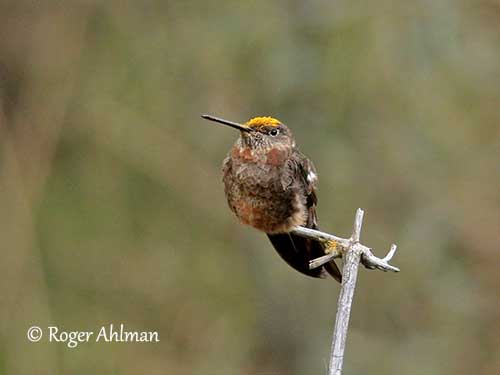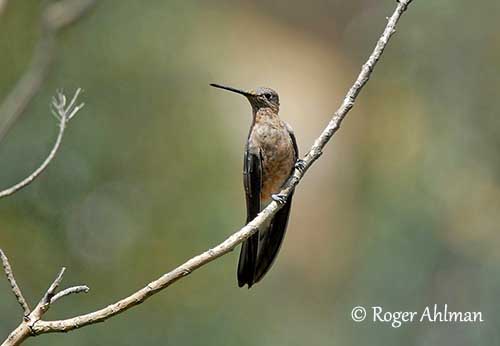
Fr: Colibri géant
Ang: Giant Hummingbird
All: Riesenkolibri
Esp: Picaflor gigante - Colibrí Gigante
Ita: Colibri Gigante
Nd: Reuzenkolibrie
Sd: Jättekolibri
Photographers:
Roger Ahlman
Pbase Galleries Peru and Ecuador
Eduardo Andrés Jordan
MIS AVES – AVES DE ARGENTINA
Philippe et Aline Wolfer
OISEAUX D'ARGENTINE
Text by Nicole Bouglouan
Sources:
HANDBOOK OF THE BIRDS OF THE WORLD Vol 5 by Josep del Hoyo-Andrew Elliott-Jordi Sargatal - Lynx Edicions - ISBN: 8487334253
Wikipedia, the free encyclopaedia
EcuRed – Conocimiento con todos y para todos
Giant Hummingbird
Patagona gigas
Apodiformes Order – Trochilidae Family
INTRODUCTION:
The Giant Hummingbird is the largest hummingbird of the family Trochilidae and the only member of the genus Patagona. It is found in South America, in Ecuador, Peru and Chile and two subspecies share the wide range.
This species is included in the subfamily Trochilinae which comprises about 90% of the species. The genus Patagona is part of the “Andean clade”. The hummingbirds of this group share several common features such as courtship behaviour, perching displays, calls and songs, nest-sites and some morphological criterions.

DESCRIPTION OF THE BIRD:
Biometrics:
Length: 20-22 cm
Wingspan: 21,5 cm
Weight: 18-23 g
The adult male of nominate race has dull olive-brown upperparts with conspicuous white rump, whereas the bronze-green uppertail-coverts are edged white. The forked tail is wedge-shaped. The bronze-green rectrices have whitish bases, but the outermost feathers show pale grey central part. The wings are dull olive-brown. They are very long and almost reach the tip of the tail when closed.
Underparts and neck sides are dull cinnamon and contrast with the white undertail-coverts.
The black bill is stout and straight. The eyes are dark brown, surrounded by narrow white feathered eyering. Legs are feathered dull cinnamon from tarsi to toes, and the feet are large and sturdy.

The female is duller overall with variably spotted grey underparts, although some females resemble males.
The immature has rufescent underparts with speckled grey throat. The upperparts show narrow scaling pattern and the flight-feathers have white edges.

SUBSPECIES AND RANGE:
The Giant Hummingbird has two recognized subspecies.
P.g. gigas is found in C and S Chile and adjacent CW Argentina. The southern populations winter N to NW Argentina. This species is regularly seen in summer in Sierras Grandes de Cordoba in C Argentina.
P.g. peruviana is found in the Andes of SW Colombia, S to extreme N Chile and NW Argentina.
This race has longer bill and wings than “gigas”. The underparts are brighter cinnamon rufous and the rump is less white. The female has duller underparts than male almost all year round.

HABITAT:
The Giant Hummingbird usually occurs in open habitats and can be seen in arid montane scrub or cultivated areas with hedgerows, and shrubby hillsides with thistles and columnar cacti.
This species frequents brushy canyons and can be seen near small streams in Ecuador and N Peru, where it occurs between 2000 and 3000 metres of elevation, occasionally up to 3300 metres. However, outside the dry season, it is found between 2500 and 4000 metres, and up to 4800 metres in Peru, Bolivia, Argentina and N Chile. The populations of S Chile occur at lower elevations, usually from sea-level up to 2000 metres.
The Giant Hummingbird is widely distributed along the Andes, on both east and west slopes.

CALLS AND SONGS: SOUNDS BY XENO-CANTO
The Giant Hummingbird’s calls are very short and uttered by both sexes. They produce a single, squeaky “squip” and a less characteristic “tee” or “zrr”. These calls are usually given from exposed perches in shrubs or at tree tops.
The chase calls are heard from birds during the defence of their feeding areas. These loud vocal signals include mixed squeaky piping whistles and trills. These sounds splay a role in field identification.


BEHAVIOUR IN THE WILD:
The Giant Hummingbird feeds on nectar from numerous plant species such as Agave and Puya flowers, Opuntia cylindrical and other tall cacti, Buddleia, Passiflora, Sittacanthus, Eucalyptus, Mutisia, Nicotiana and Lobelia.
It particularly favours nectar from Oreocereus celsianus, and from the similar, but smaller, Cleistocactus tupizensis. The first plant is flowering during the entire wet season.
The Giant Hummingbird hovers less frequently than most Trochilidae. It mostly perches or clings to a stem, and while remaining on the petals, it pushes its head into the flower to get the nectar.
Insects are taken too, mainly by hawking rather than hovering, and by catching them from the flower.
While feeding, the Giant Hummingbird can be relatively aggressive. It is also territorial and defends its foraging areas. It may attack other bird species and even large insects feeding at flowering plants, in order to displace and chase them.

There is no pair-bond between mates, and they separate after the copulation. The males sing and perform aerial displays to attract females, flying in U-shaped pattern in front of them. Males are polygynous and mate with several females during this period. The female performs alone all the nesting duties.
The Giant Hummingbird of nominate race leaves its breeding grounds in Chile and CS Argentina to migrate across the Andes to NW Argentina in autumn and winter.
The race “peruviana” is less studied, but these birds probably move according to Agave flowering.
The Giant Hummingbird performs 8 to 10-15 wingbeats/second that is much slower than small hummingbirds which perform 70 wingbeats/second, and up to 200 during the displays.

REPRODUCTION OF THIS SPECIES:
The breeding season varies depending on the range, and takes place between December and March in Ecuador, in September/March in Peru, and between October and January in Chile.
The nest is placed in large bush or tree, often Eucalyptus or poplar, but also on top of cactus, often 2-4 metres above the ground. The female builds the nest.
The small structure is attached to a branch and made with moss and lichens, and lined with soft materials, often sheep wool. The outer part is covered with spider webs. The nest is usually built in an area near water.

The female lays 1-2 white eggs, usually two. She incubates alone during 12-13 days. The chicks are fed with semi-digested insects, regurgitated by the female directly into the stomach of the chick, thanks to the long bill. During this period, she may catch up to 2000 insects per day.
The chicks leave the nest about 20 days after hatching, when they become too large for the small nest.

PROTECTION / THREATS / STATUS:
The Giant Hummingbird is described as uncommon throughout its large range. It has adapted to man-made habitats, and occurs in national parks and protected areas.
The population size is unknown, but it is suspected to be stable, and currently, the Giant Hummingbird is evaluated as Least Concern.

